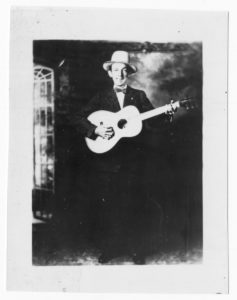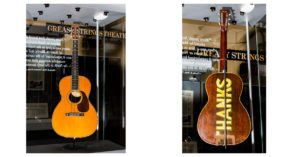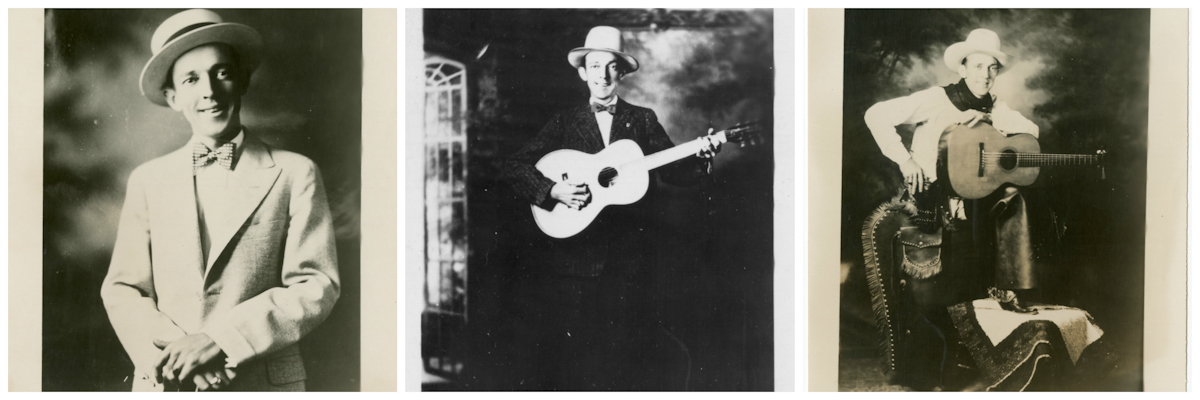Did you know that last year the Birthplace of Country Music Museum took in on loan one of the most important guitars in American music history – Jimmie Rodgers’ 1928 000-45 Martin? Yep, it’s true, and it’s currently on display here at the museum!

Jimmie Rodgers. From the John Edwards Memorial Foundation Records, #20001, Southern Folklife Collection, Wilson Library, University of North Carolina at Chapel Hill
Over the years this guitar has become one of the most iconic symbols for country music, boasting a mother of pearl neck inlay touting Jimmie Rodgers’ name, an iconic hand-painted “THANKS” on the back of the guitar, the words “Blue Yodel” in inlay on the headstock, and a label on the interior with a message signed by C. F. Martin himself. Of course, the guitar was made famous by not only Rodgers – recognized as “the Father of Country Music” and also known as “the Singing Brakeman” and “America’s Blue Yodeler” – but also by honky tonk great Ernest Tubb, who was loaned the famous guitar by Jimmie’s widow Carrie Rodgers. Ernest went on to play the guitar for nearly 40 years, helping to solidify its importance in the history of country music.

Jimmie Rodgers’ 1928 Martin 000-45 on display at the Birthplace of Country Music Museum. © Birthplace of Country Music; photographer: Ashli Linkous
To celebrate this iconic guitar in its temporary home here at the Birthplace of Country Music Museum, Clint Holley – Radio Bristol DJ and host of “Pressing Matters” – has been working with museum and radio staff to create and share a three-episode program featuring perspectives from scholars and musicians from across the country. Titled “Instrumental History: Thoughts & Anecdotes on Jimmie Rodgers Martin 000-45 ‘Blue Yodel’ Guitar,” the program will air on Fridays at 6:00 pm ET on Radio Bristol for the next six weeks launching Friday, February 3 – each episode will be aired two week in a row. And so, in other words, tune in tonight for the first one!
To get us warmed up and ready for the series, we asked some of our knowledgeable Radio Bristol DJs to tell us about their favorite Jimmie Rodger’s songs, whether sung by him or a cover by another artist. Our DJs came through with some great, if not surprising, choices.
Crystal Gayle, “Miss the Mississippi and You”
“A thoroughly modern take on this classic song. Although NOT written by Jimmie, he made it his own and was the first to release it in 1932. The song has been recorded over 40 times, and Crystal’s version is the first I could find with a female singer as the main character. Produced with contemporary sounds in the late 1970s, this version shows how flexible and enduring the song truly is.”
~ Clint Holley, Pressing Matters
Jorma Kaukonen, “Prohibition Blues”
“I want to nominate Jorma Kaukonen’s version of Jimmie’s never-recovered master of “Prohibition Blues” from his album Blue Country Heart as my favorite…both for its rarity and its timely nature. The fact that he had the writer, Clayton McMichen, play on his recording of it is even more interesting and shows how much respect Rodgers had for his fellow musicians. As a collector’s aside, can you imagine finding that master sitting in a dusty storeroom somewhere today? Talk about your Holy Grail! It would probably be worth more than the 000-45 that we are so lucky to get to display!
Jorma’s version is, of course, outstanding as well with a superb lineup, and he does it justice with humor and flawless musicianship. I will admit to prejudice here, because Jorma is a good friend whose music is a large part of my repertoire…but his choice of that song is a rare treat for us all.”
~ Marshall Ballew, Off the Beaten Track
Jimmie Rodgers, “Waiting for a Train”
“Two of Jimmie Rodgers’ tunes that I have always connected with are “Waiting for a Train” and “Miss the Mississippi and You.” Jimmie wrote his version of “Waiting for a Train” based on an English tune from the 19th century. He recorded it in 1929 for Ralph Peer’s Victor label on the back side of “Blue Yodel #4.” I have always liked the horns at the beginning; they resonate with my traditional jazz roots. “Miss the Mississippi and You“ was recorded later and has that feeling, to me, that Jimmie knew his time was increasingly short. I think Jimmie was able to translate a number of types of music into his own unique style, which is why he was so popular. I hear the music of Western styles in his yodel and jazz in his singing, coupled with the Delta blues and Appalachian sounds. It is a compelling combination. He also recorded long enough that his later songs were technologically better recorded than his early stuff. He was a true artist who died way too young.”
~ Bill Smith – Crooked Road Radio Hour
Jimmie Rodgers, “Last Blue Yodel”
“A part of Jimmie Rodgers’ final group of recordings, performed during the sessions that took place in New York City just 48 hours before his untimely death, “Last Blue Yodel” is a poignant soliloquy relinquishing personal thoughts on heartbreak. Following a 12-bar-blues format paired with Jimmie’s trademark yodeling, which Rodgers employed on all of his series of 13 Blue Yodels, this last one has become my favorite for its directness and intensity. The tag of each verse admits “The women make a fool out of me.” Rodgers known for his intimate solo guitar style is also one of the first singers to display confessional songwriting, which has deeply shaped country music as a genre, and my own personal approach to creating songs.”
Leon Redbone, “T.B. Blues”
“My personal favorite cover version of a Jimmie Rodgers song is Leon Redbone’s rendition of “T.B. Blues.” The song itself always stood out to me because of the unique perspective of writing so specifically about one’s own mortality. It was covered by several bluesmen that I took to when I first started researching the blues, but Redbone’s version has the perfect amount of his own style while still paying homage to the original.”
~ Scotty Almany, Scotty’s Tune Up
Kris Truelsen is the Radio Bristol Program Director.








